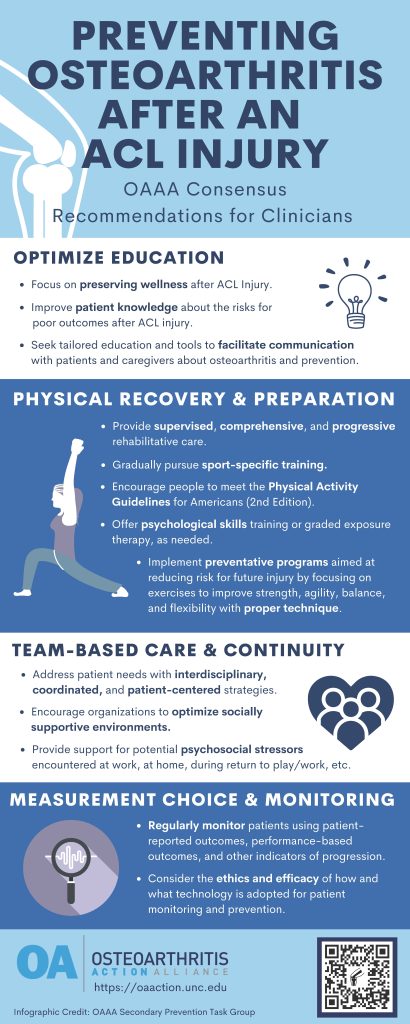Secondary Prevention
Preventing Osteoarthritis After an Anterior Cruciate Ligament (ACL) Injury
ACL reconstruction often leads to positive outcomes for the patient, including return to physical activities (e.g., sport, occupational, recreational). However, at least 1 in 3 young patients with a knee injury will go on to develop knee osteoarthritis (OA), a serious, chronic and progressive disease that will affect them for most of their lives.
The Secondary Prevention Task force is committed to developing resources for patients, family members, and clinicians to help highlight the best practices for:
- Individuals at risk for OA
- Effective treatment approaches
- Educational strategies
The consensus statement and accompanying resources below offer recommendations on ways to reduce the long-term burden of knee OA among individuals with a history of ACL injury.
The overall strategy is to identify poor outcomes as soon as possible and to initiate and optimize treatments early that halt or slow OA progression and its effect on someone’s quality of life.
Short- to Mid-Term Goals for Clinicians
- Promote a patient’s role in shared and informed decision-making around their care
- Educate individuals concerning:
- Their injury and recovery (e.g., what to expect, long-term risks, risk modifiers)
- Coping strategies
- Maintaining or improving self-efficacy
- The importance of adherence
- Stress management
- Goal setting
- Optimize physical activity
- A total return to previous activities or activity modification
- Prevent or reduce chronic symptoms, including:
- Knee pain
- Poor quality of life
- Functional limitations
- Fear of re-injury
- Prevent subsequent injuries
- Reduce psychological stress related to:
- Return to activity
- Communication with a clinician
Future Resources
The first round of resources are geared towards clinicians, but we are planning to create patient- and family member-specific resources in the near future. We also welcome ideas and input – please see below for how to get involved if you have an interest!
- Infographic for patients
- Consumer information and educational resources for patients
- Educational resources for healthcare professionals (including conference presentations)
- Mobile application
- Coordinated Care Program
Get Involved
If you are interested in volunteering to serve on the Secondary Prevention Task Group, please contact us. The task group includes clinicians and researchers from a variety of healthcare-related fields and is interested in collaborating with patients, family members, and other stakeholders working towards preventing the long-term burden of OA after an ACL injury.
The team at OAAA would like to thank the entire Secondary Prevention Task Group for their contributions. In particular:
Jeffrey B Driban, Heather K Vincent, Thomas H Trojian, Kirsten R Ambrose, Shelby Baez, Nicholas Beresic, David J Berkoff, Leigh F Callahan, Bruce Cohen, Madison Franek, Yvonne M Golightly, Matthew Harkey, Christopher M Kuenze, Mary Catherine Minnig, Ali Mobasheri, Adam Naylor, Connie B Newman, Darin A Padua, Brian Pietrosimone, Daniel Pinto, Hayley Root, Stephanie Rosado, Matthew Salzler, Laura C Schmitt, Lynn Snyder-Mackler, Jeffrey B Taylor, Louise M Thomas, Kevin R Vincent, Elizabeth Wellsandt, and Monette Williams.

